RENAULT SANDERO 2012 Owner's Manual
Manufacturer: RENAULT, Model Year: 2012, Model line: SANDERO, Model: RENAULT SANDERO 2012Pages: 183, PDF Size: 6.95 MB
Page 21 of 183
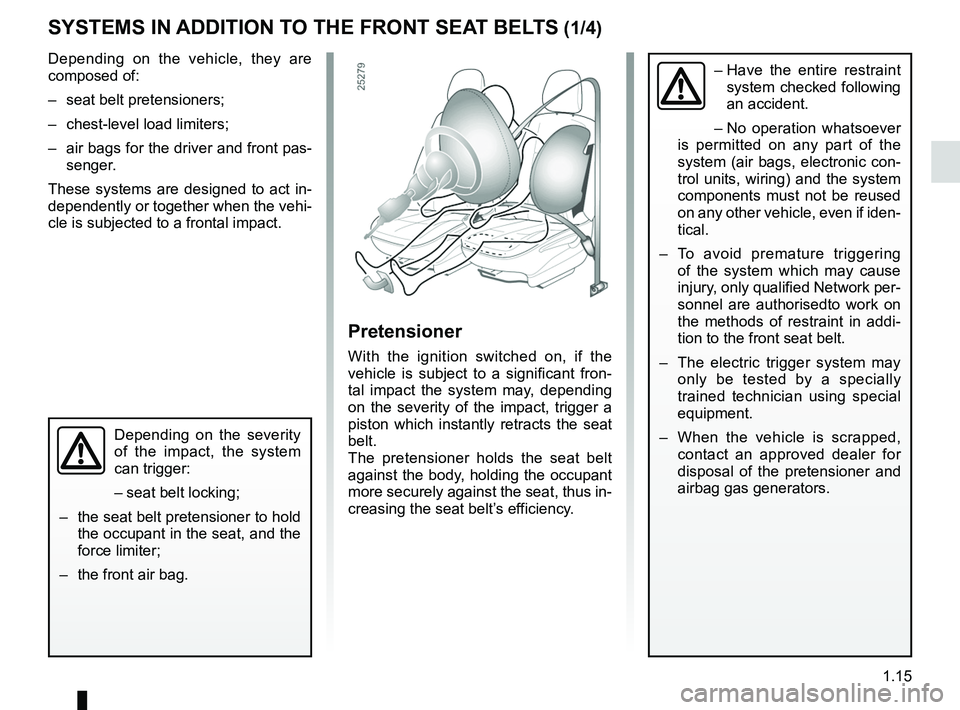
air bag................................................... (up to the end of the DU)
seat belts .............................................. (up to the end of the DU)
methods of restraint in addition to the front seat belts
(up to the end of the DU)
1.15
ENG_UD19962_9
Dispositifs complémentaires à la ceinture avant (B90 - L90 Ph2 - \
F90 Ph2 - R90 Ph2 - Dacia)
ENG_NU_817-9_B90_Dacia_1
Methods of restraint in addition to the front seat belts
SYSTEMS IN ADDITION TO THE FRONT SEAT BELTS (1/4)
Depending on the vehicle, they are
composed of:
– seat belt pretensioners;
– chest-level load limiters;
– air bags for the driver and front pas-
senger.
These systems are designed to act in-
dependently or together when the vehi-
cle is subjected to a frontal impact.– Have the entire restraint
system checked following
an accident.
– No operation whatsoever
is permitted on any part of the
system (air bags, electronic con-
trol units, wiring) and the system
components must not be reused
on any other vehicle, even if iden -
tical.
– To avoid premature triggering
of the system which may cause
injury, only qualified Network per-
sonnel are authorisedto work on
the methods of restraint in addi -
tion to the front seat belt.
– The electric trigger system may
only be tested by a specially
trained technician using special
equipment.
– When the vehicle is scrapped,
contact an approved dealer for
disposal of the pretensioner and
airbag gas generators.
Pretensioner
With the ignition switched on, if the
vehicle is subject to a significant fron -
tal impact the system may, depending
on the severity of the impact, trigger a
piston which instantly retracts the seat
belt.
The pretensioner holds the seat belt
against the body, holding the occupant
more securely against the seat, thus in-
creasing the seat belt’s efficiency.
Depending on the severity
of the impact, the system
can trigger:
– seat belt locking;
– the seat belt pretensioner to hold
the occupant in the seat, and the
force limiter;
– the front air bag.
Page 22 of 183
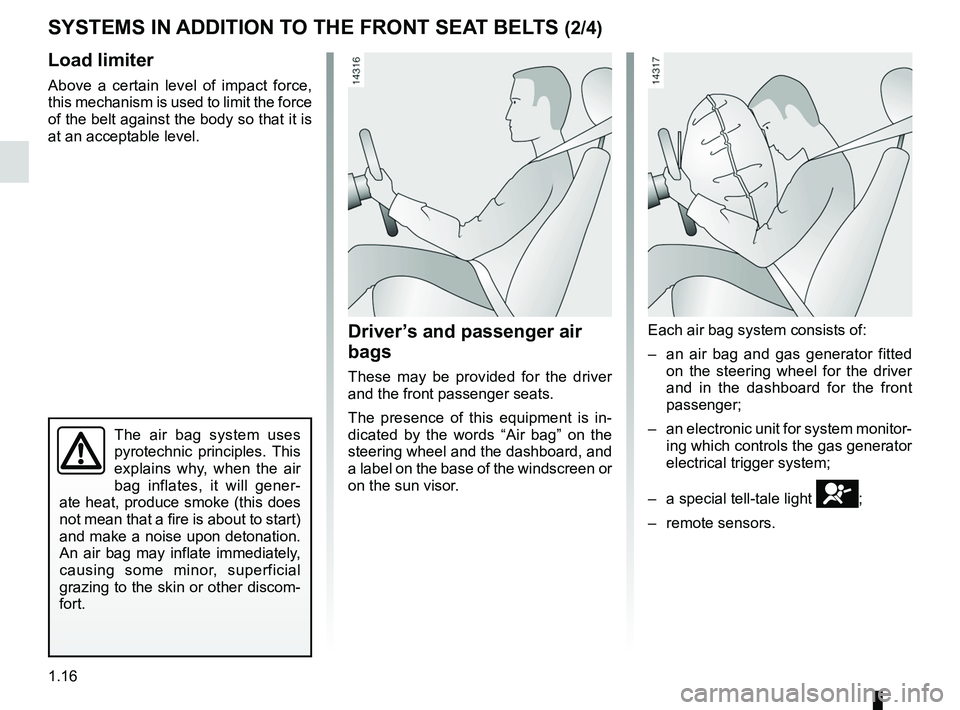
1.16
ENG_UD19962_9
Dispositifs complémentaires à la ceinture avant (B90 - L90 Ph2 - \
F90 Ph2 - R90 Ph2 - Dacia)
ENG_NU_817-9_B90_Dacia_1
Jaune NoirNoir texte
SYSTEMS IN ADDITION TO THE FRONT SEAT BELTS (2/4)
Driver’s and passenger air
bags
These may be provided for the driver
and the front passenger seats.
The presence of this equipment is in -
dicated by the words “Air bag” on the
steering wheel and the dashboard, and
a label on the base of the windscreen or
on the sun visor.
Each air bag system consists of:
– an air bag and gas generator fitted
on the steering wheel for the driver
and in the dashboard for the front
passenger;
– an electronic unit for system monitor-
ing which controls the gas generator
electrical trigger system;
– a special tell-tale light
å;
– remote sensors.
Load limiter
Above a certain level of impact force,
this mechanism is used to limit the force
of the belt against the body so that it is
at an acceptable level.
The air bag system uses
pyrotechnic principles. This
explains why, when the air
bag inflates, it will gener -
ate heat, produce smoke (this does
not mean that a fire is about to start)
and make a noise upon detonation.
An air bag may inflate immediately,
causing some minor, superficial
grazing to the skin or other discom-
fort.
Page 23 of 183

JauneNoirNoir texte
1.17
ENG_UD19962_9
Dispositifs complémentaires à la ceinture avant (B90 - L90 Ph2 - \
F90 Ph2 - R90 Ph2 - Dacia)
ENG_NU_817-9_B90_Dacia_1
SYSTEMS IN ADDITION TO THE FRONT SEAT BELTS (3/4)
Operation
This system is only operational when
the ignition is switched on.
If a severe frontal impact occurs, the
air bag(s) inflate(s) rapidly, cushion -
ing the impact of the driver’s head and
chest against the steering wheel and
the front passenger’s head against the
dashboard. The air bag then deflates
immediately so that the passengers are
not impeded in any way when they get
out of the vehicle.
Operating faults
Warning light 1 will light up on the in -
strument panel when the ignition is
turned on and then go out after a few
seconds.
If it does not light up when the ignition
is switched on, or comes on when the
engine is running, there is a fault in the
system. In this case, a child seat MUST NOT be
fitted to the front passenger seat.
Allowing any other passenger to sit in
that seat is not recommended.
In these two cases, contact an ap
-
proved dealer as soon as possible.
The air bag system uses
pyrotechnic principles. This
explains why, when the air
bag inflates, it will gener -
ate heat, produce smoke (this does
not mean that a fire is about to start)
and make a noise upon detonation.
In a situation where an air bag is
required, it will inflate immediately
and this may cause some minor, su-
perficial grazing to the skin or other
problems.
1
Page 24 of 183
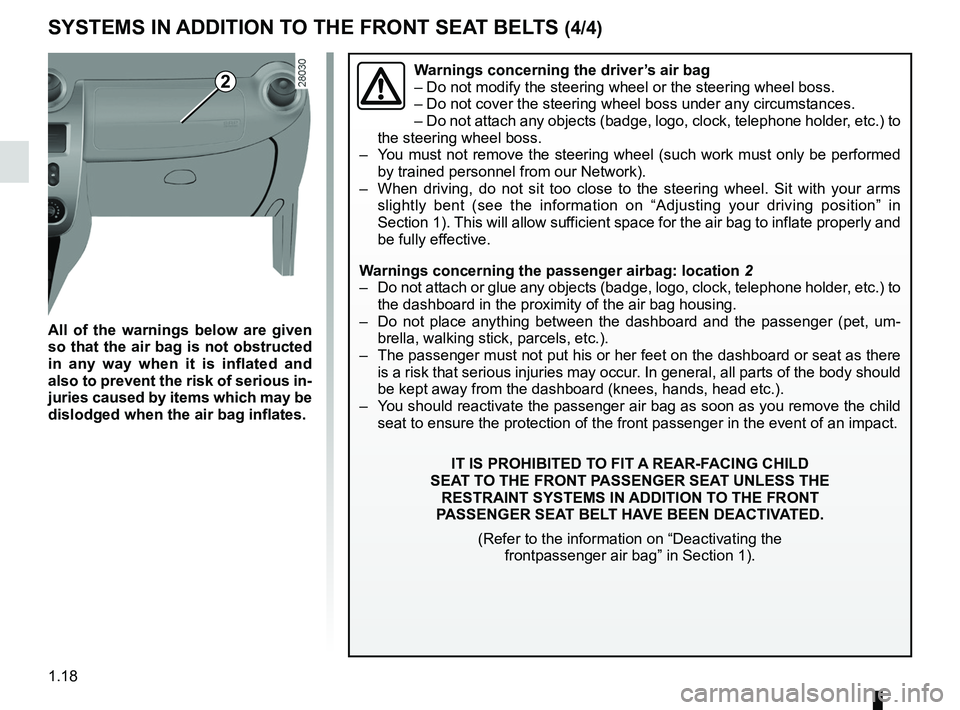
1.18
ENG_UD19962_9
Dispositifs complémentaires à la ceinture avant (B90 - L90 Ph2 - \
F90 Ph2 - R90 Ph2 - Dacia)
ENG_NU_817-9_B90_Dacia_1
SYSTEMS IN ADDITION TO THE FRONT SEAT BELTS (4/4)
All of the warnings below are given
so that the air bag is not obstructed
in any way when it is inflated and
also to prevent the risk of serious in-
juries caused by items which may be
dislodged when the air bag inflates.
Warnings concerning the driver’s air bag
– Do not modify the steering wheel or the steering wheel boss.
– Do not cover the steering wheel boss under any circumstances.
– Do not attach any objects (badge, logo, clock, telephone holder, etc.) to
the steering wheel boss.
– You must not remove the steering wheel (such work must only be performed
by trained personnel from our Network).
– When driving, do not sit too close to the steering wheel. Sit with your arms
slightly bent (see the information on “Adjusting your driving position” in
Section 1). This will allow sufficient space for the air bag to inflate properly and
be fully effective.
Warnings concerning the passenger airbag: location 2
– Do not attach or glue any objects (badge, logo, clock, telephone holder, etc.) to
the dashboard in the proximity of the air bag housing.
– Do not place anything between the dashboard and the passenger (pet, um -
brella, walking stick, parcels, etc.).
– The passenger must not put his or her feet on the dashboard or seat as there
is a risk that serious injuries may occur. In general, all parts of the body should
be kept away from the dashboard (knees, hands, head etc.).
– You should reactivate the passenger air bag as soon as you remove the child
seat to ensure the protection of the front passenger in the event of an \
impact.
IT IS PROHIBITED TO FIT A REAR-FACING CHILD
SEAT TO THE FRONT PASSENGER SEAT UNLESS THE RESTRAINT SYSTEMS IN ADDITION TO THE FRONT
PASSENGER SEAT BELT HAVE BEEN DEACTIVATED.
(Refer to the information on “Deactivating the frontpassenger air bag” in Section 1).2
Page 25 of 183
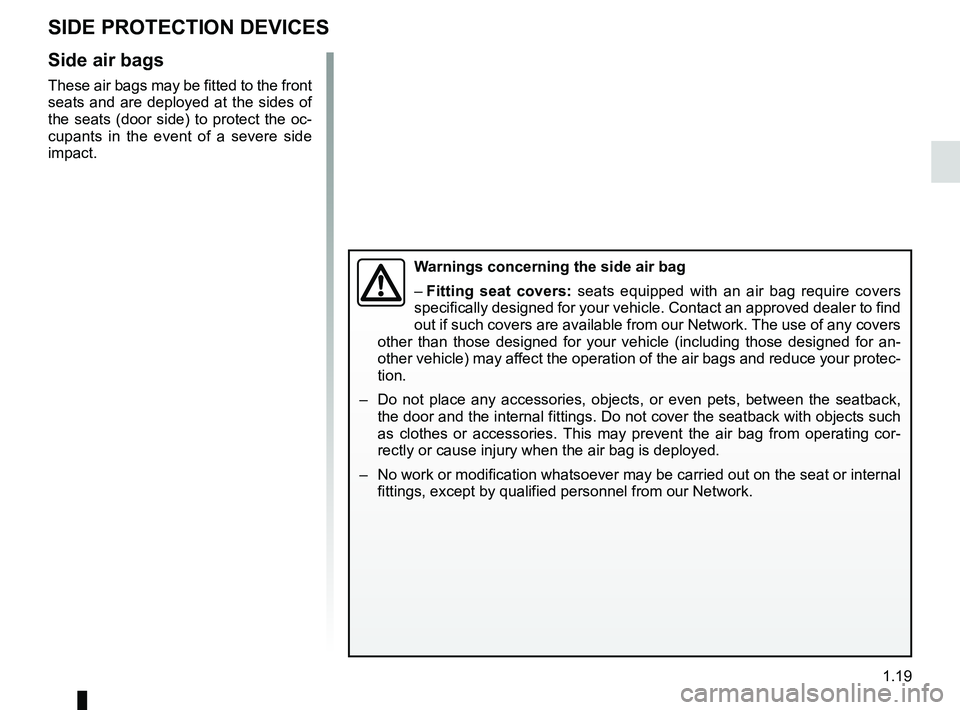
seat belts .............................................. (up to the end of the DU)
air bag ................................................... (up to the end of the DU)
1.19
ENG_UD18027_3
Dispositifs de protection latérale (B90 - L90 Ph2 - H79 - Dacia)
ENG_NU_817-9_B90_Dacia_1
Side protection devices
SIDE PROTECTION DEVICES
Side air bags
These air bags may be fitted to the front
seats and are deployed at the sides of
the seats (door side) to protect the oc-
cupants in the event of a severe side
impact.
Warnings concerning the side air bag
– Fitting seat covers: seats equipped with an air bag require covers
specifically designed for your vehicle. Contact an approved dealer to find
out if such covers are available from our Network. The use of any covers
other than those designed for your vehicle (including those designed for an-
other vehicle) may affect the operation of the air bags and reduce your protec-
tion.
– Do not place any accessories, objects, or even pets, between the seatback,
the door and the internal fittings. Do not cover the seatback with objects such
as clothes or accessories. This may prevent the air bag from operating cor -
rectly or cause injury when the air bag is deployed.
– No work or modification whatsoever may be carried out on the seat or internal
fittings, except by qualified personnel from our Network.
Page 26 of 183
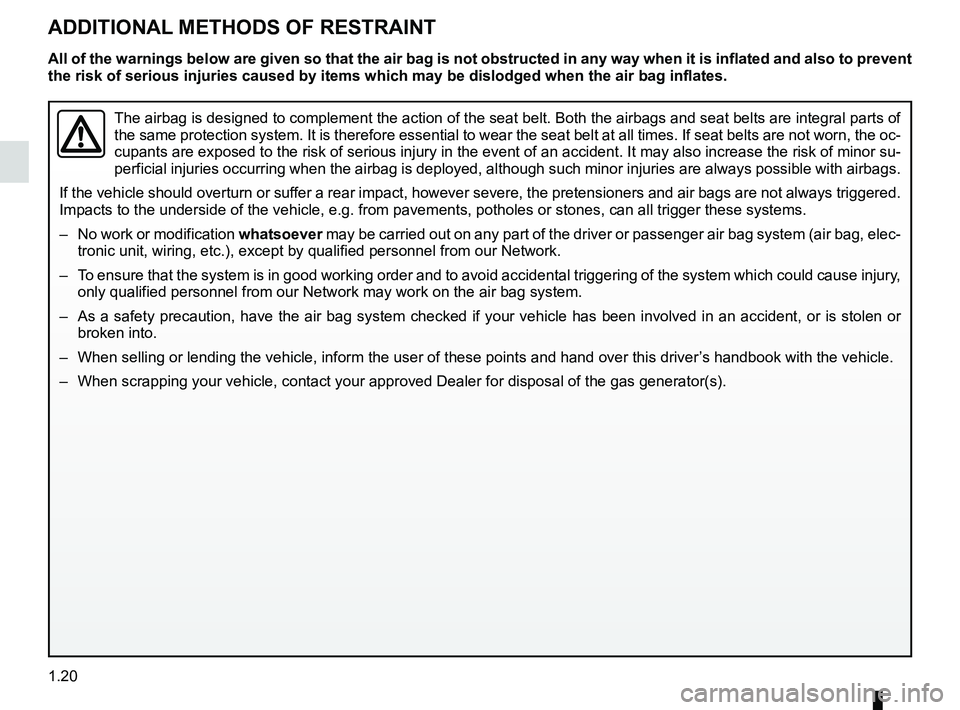
air bag.................................................................... (current page)
seat belts ............................................................... (current page)
methods of restraint in addition to the front seat belts
(current page)
1.20
ENG_UD18226_6
Dispositifs de retenue complémentaires (B90 - L90 Ph2 - Dacia)
ENG_NU_817-9_B90_Dacia_1
Additional methods of restraint
The airbag is designed to complement the action of the seat belt. Both the airbags and seat belts are integral parts of
the same protection system. It is therefore essential to wear the seat belt at all times. If seat belts are not worn, the oc-
cupants are exposed to the risk of serious injury in the event of an accident. It may also increase the risk of minor su-
perficial injuries occurring when the airbag is deployed, although such minor injuries are always possible with airbags.
If the vehicle should overturn or suffer a rear impact, however severe, the pretensioners and air bags are not always triggered.
Impacts to the underside of the vehicle, e.g. from pavements, potholes o\
r stones, can all trigger these systems.
– No work or modification whatsoever may be carried out on any part of the driver or passenger air bag system (air bag, elec-
tronic unit, wiring, etc.), except by qualified personnel from our Netw\
ork.
– To ensure that the system is in good working order and to avoid accidental triggering of the system which could cause injury,
only qualified personnel from our Network may work on the air bag system\
.
– As a safety precaution, have the air bag system checked if your vehicle has been involved in an accident, or is stolen or
broken into.
– When selling or lending the vehicle, inform the user of these points and hand over this driver’s handbook with the vehicle.
– When scrapping your vehicle, contact your approved Dealer for disposal of the gas generator(s).
All of the warnings below are given so that the air bag is not obstructed in any way when it is inflated and also to prevent
the risk of serious injuries caused by items which may be dislodged when\
the air bag inflates.
ADDITIONAL METHODS OF RESTRAINT
Page 27 of 183
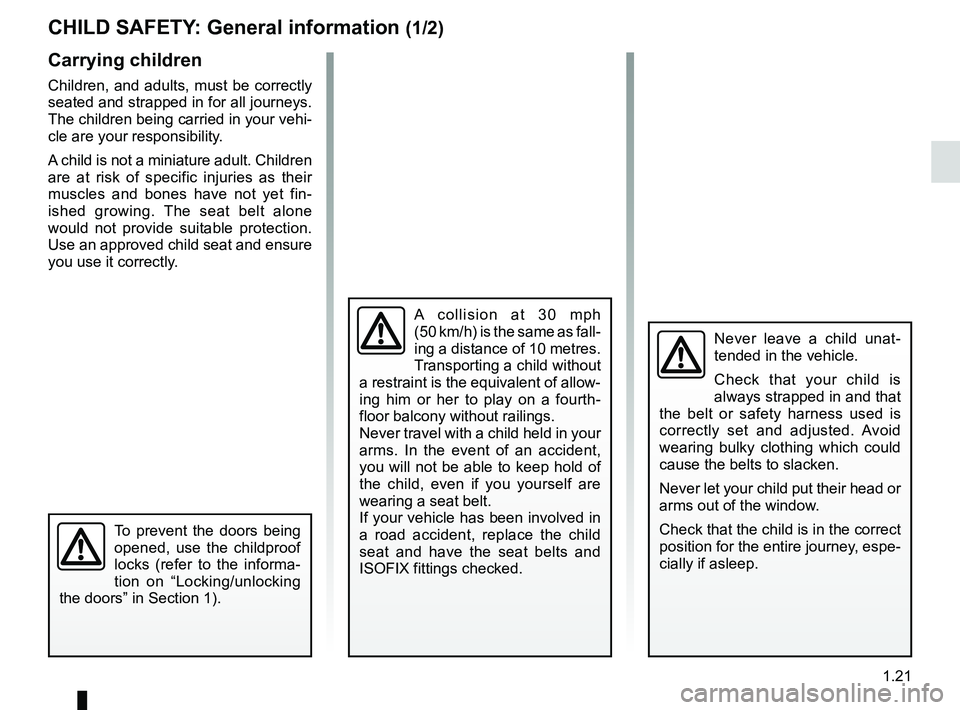
child restraint/seat ................................ (up to the end of the DU)
child restraint/seat ................................ (up to the end of the DU)
child restraint/seat ................................ (up to the end of the DU)
child seats ............................................. (up to the end of the DU)
child booster seat ................................. (up to the end of the DU)
transporting children ............................. (up to the end of the DU)
child safety ............................................ (up to the end of the DU)
1.21
ENG_UD24012_11
Sécurite enfants : généralités (B90 - F90 - U90 - R90 - F90\
Ph2 - R90 Ph2 - H79 - Dacia)
ENG_NU_817-9_B90_Dacia_1
Child safety: general information
CHILD SAFETY : General information (1/2)
Carrying children
Children, and adults, must be correctly
seated and strapped in for all journeys.
The children being carried in your vehi-
cle are your responsibility.
A child is not a miniature adult. Children
are at risk of specific injuries as their
muscles and bones have not yet fin -
ished growing. The seat belt alone
would not provide suitable protection.
Use an approved child seat and ensure
you use it correctly.
A collision at 30 mph
(50 km/h) is the same as fall-
ing a distance of 10 metres.
Transporting a child without
a restraint is the equivalent of allow-
ing him or her to play on a fourth -
floor balcony without railings.
Never travel with a child held in your
arms. In the event of an accident,
you will not be able to keep hold of
the child, even if you yourself are
wearing a seat belt.
If your vehicle has been involved in
a road accident, replace the child
seat and have the seat belts and
ISOFIX fittings checked.
Never leave a child unat -
tended in the vehicle.
Check that your child is
always strapped in and that
the belt or safety harness used is
correctly set and adjusted. Avoid
wearing bulky clothing which could
cause the belts to slacken.
Never let your child put their head or
arms out of the window.
Check that the child is in the correct
position for the entire journey, espe-
cially if asleep.
To prevent the doors being
opened, use the childproof
locks (refer to the informa -
tion on “Locking/unlocking
the doors” in Section 1).
Page 28 of 183
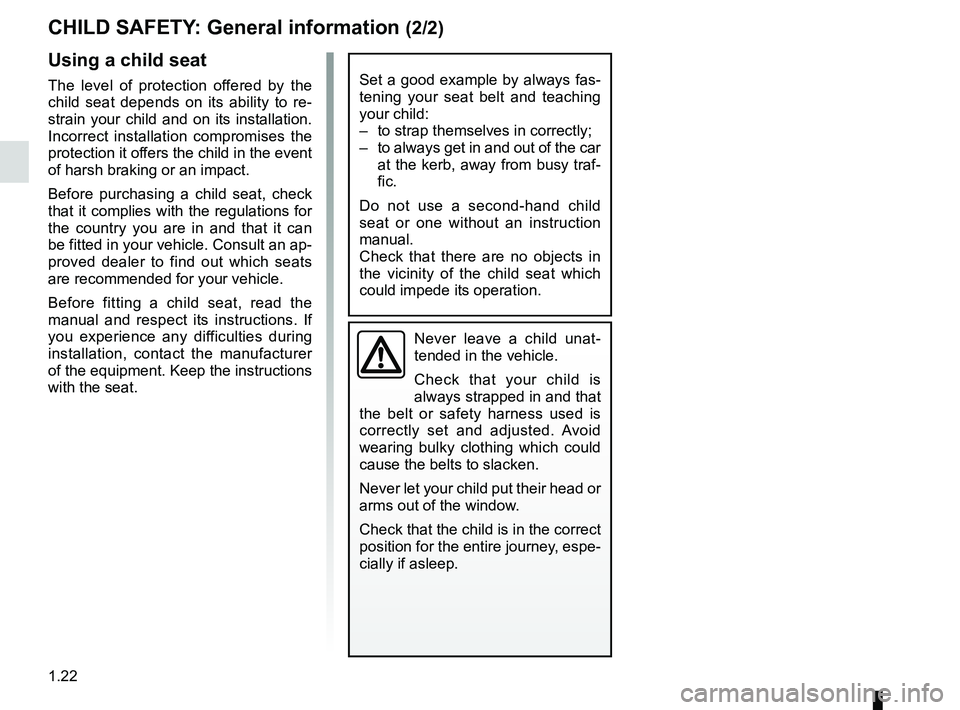
1.22
ENG_UD24012_11
Sécurite enfants : généralités (B90 - F90 - U90 - R90 - F90\
Ph2 - R90 Ph2 - H79 - Dacia)
ENG_NU_817-9_B90_Dacia_1
Jaune NoirNoir texte
CHILD SAFETY : General information (2/2)
Using a child seat
The level of protection offered by the
child seat depends on its ability to re -
strain your child and on its installation.
Incorrect installation compromises the
protection it offers the child in the event
of harsh braking or an impact.
Before purchasing a child seat, check
that it complies with the regulations for
the country you are in and that it can
be fitted in your vehicle. Consult an ap-
proved dealer to find out which seats
are recommended for your vehicle.
Before fitting a child seat, read the
manual and respect its instructions. If
you experience any difficulties during
installation, contact the manufacturer
of the equipment. Keep the instructions
with the seat.Set a good example by always fas-
tening your seat belt and teaching
your child:
– to strap themselves in correctly;
– to always get in and out of the car
at the kerb, away from busy traf-
fic.
Do not use a second-hand child
seat or one without an instruction
manual.
Check that there are no objects in
the vicinity of the child seat which
could impede its operation.
Never leave a child unat -
tended in the vehicle.
Check that your child is
always strapped in and that
the belt or safety harness used is
correctly set and adjusted. Avoid
wearing bulky clothing which could
cause the belts to slacken.
Never let your child put their head or
arms out of the window.
Check that the child is in the correct
position for the entire journey, espe-
cially if asleep.
Page 29 of 183
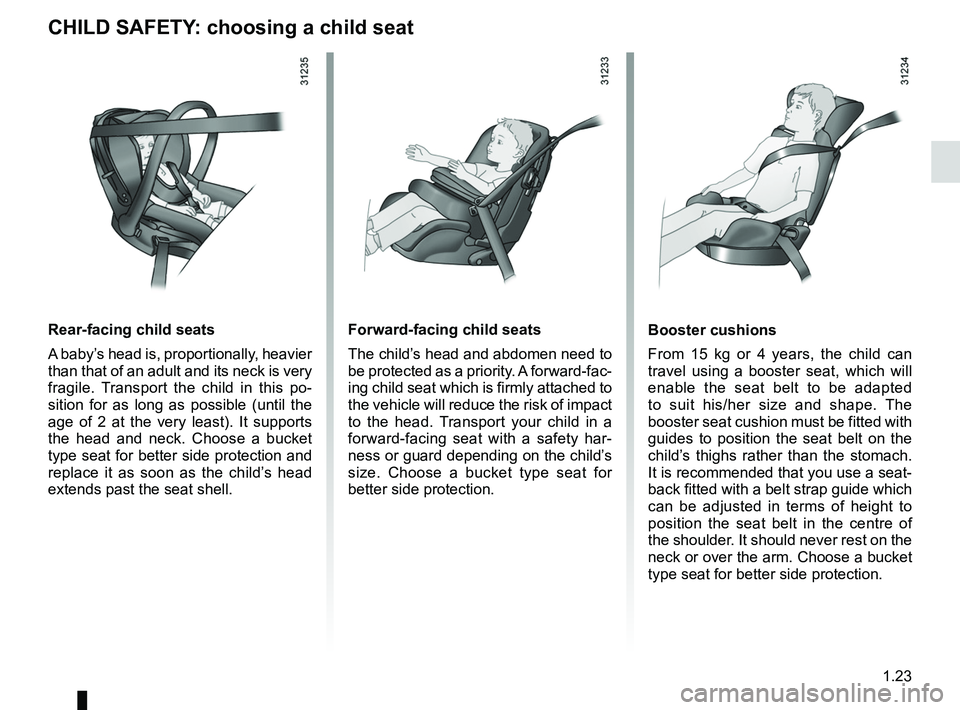
JauneNoirNoir texte
1.23
ENG_UD24012_11
Sécurite enfants : généralités (B90 - F90 - U90 - R90 - F90\
Ph2 - R90 Ph2 - H79 - Dacia)
ENG_NU_817-9_B90_Dacia_1
Booster cushions
From 15 kg or 4 years, the child can
travel using a booster seat, which will
enable the seat belt to be adapted
to suit his/her size and shape. The
booster seat cushion must be fitted with
guides to position the seat belt on the
child’s thighs rather than the stomach.
It is recommended that you use a seat-
back fitted with a belt strap guide which
can be adjusted in terms of height to
position the seat belt in the centre of
the shoulder. It should never rest on the
neck or over the arm. Choose a bucket
type seat for better side protection.
Forward-facing child seats
The child’s head and abdomen need to
be protected as a priority. A forward-fac-
ing child seat which is firmly attached to
the vehicle will reduce the risk of impact
to the head. Transport your child in a
forward-facing seat with a safety har
-
ness or guard depending on the child’s
size. Choose a bucket type seat for
better side protection.
Rear-facing child seats
A baby’s head is, proportionally, heavier
than that of an adult and its neck is very
fragile. Transport the child in this po
-
sition for as long as possible (until the
age of 2 at the very least). It supports
the head and neck. Choose a bucket
type seat for better side protection and
replace it as soon as the child’s head
extends past the seat shell.
CHILD SAFETY : choosing a child seat
Page 30 of 183
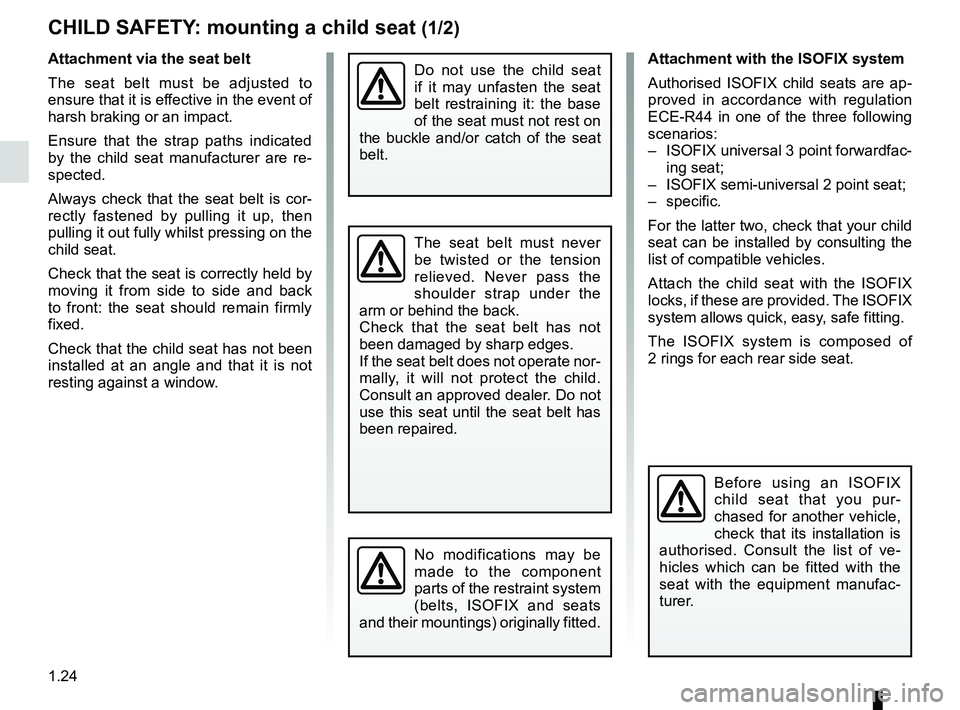
child restraint/seat ................................ (up to the end of the DU)
child restraint/seat ................................ (up to the end of the DU)
child restraint/seat ................................ (up to the end of the DU)
child safety ............................................ (up to the end of the DU)
child seats ............................................. (up to the end of the DU)
transporting children ............................. (up to the end of the DU)
1.24
ENG_UD22573_6
Sécurité enfants : fixation du siège enfant (B90 - Dacia)
ENG_NU_817-9_B90_Dacia_1
Jaune NoirNoir texte
mounting a child seat
CHILD SAFETY : mounting a child seat (1/2)
Attachment via the seat belt
The seat belt must be adjusted to
ensure that it is effective in the event of
harsh braking or an impact.
Ensure that the strap paths indicated
by the child seat manufacturer are re -
spected.
Always check that the seat belt is cor-
rectly fastened by pulling it up, then
pulling it out fully whilst pressing on the
child seat.
Check that the seat is correctly held by
moving it from side to side and back
to front: the seat should remain firmly
fixed.
Check that the child seat has not been
installed at an angle and that it is not
resting against a window. Attachment with the ISOFIX system
Authorised ISOFIX child seats are ap
-
proved in accordance with regulation
ECE-R44 in one of the three following
scenarios:
– ISOFIX universal 3 point forwardfac-
ing seat;
– ISOFIX semi-universal 2 point seat;
– specific.
For the latter two, check that your child
seat can be installed by consulting the
list of compatible vehicles.
Attach the child seat with the ISOFIX
locks, if these are provided. The ISOFIX
system allows quick, easy, safe fitting.
The ISOFIX system is composed of
2 rings for each rear side seat.
Before using an ISOFIX
child seat that you pur -
chased for another vehicle,
check that its installation is
authorised. Consult the list of ve -
hicles which can be fitted with the
seat with the equipment manufac -
turer.
No modifications may be
made to the component
parts of the restraint system
(belts, ISOFIX and seats
and their mountings) originally fitted.
The seat belt must never
be twisted or the tension
relieved. Never pass the
shoulder strap under the
arm or behind the back.
Check that the seat belt has not
been damaged by sharp edges.
If the seat belt does not operate nor-
mally, it will not protect the child.
Consult an approved dealer. Do not
use this seat until the seat belt has
been repaired.
Do not use the child seat
if it may unfasten the seat
belt restraining it: the base
of the seat must not rest on
the buckle and/or catch of the seat
belt.